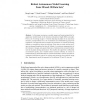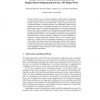367 search results - page 1 / 74 » Robust Autonomous Model Learning from 2D and 3D Data Sets |
MICCAI
2007
Springer
14 years 11 months ago
2007
Springer
In this paper we propose a weakly supervised learning algorithm for appearance models based on the minimum description length (MDL) principle. From a set of training images or volu...
BMVC
2010
14 years 2 months ago
2010
Recognizing 3D objects from arbitrary view points is one of the most fundamental problems in computer vision. A major challenge lies in the transition between the 3D geometry of o...
NIPS
2003
14 years 6 months ago
2003
This paper presents an algorithm for learning the time-varying shape of a non-rigid 3D object from uncalibrated 2D tracking data. We model shape motion as a rigid component (rotat...
CVPR
2008
IEEE
14 years 11 months ago
2008
IEEE
We propose a person-dependent, manifold-based approach for modeling and tracking rigid and nonrigid 3D facial deformations from a monocular video sequence. The rigid and nonrigid ...
ECCV
2008
Springer
15 years 6 months ago
2008
Springer
In this work, we present an approach to jointly segment a rigid object in a 2D image and estimate its 3D pose, using the knowledge of a 3D model. We naturally couple the two proces...


